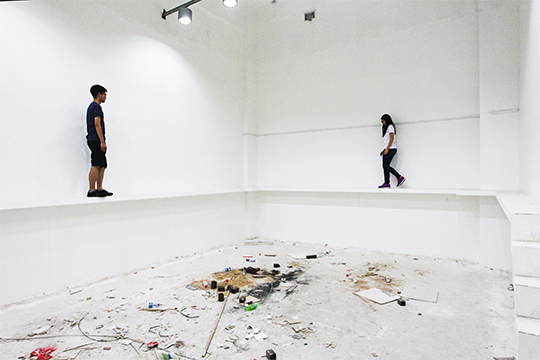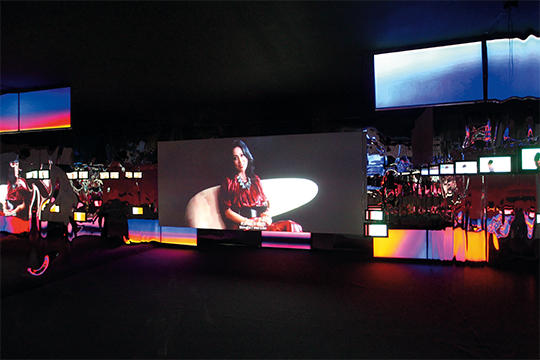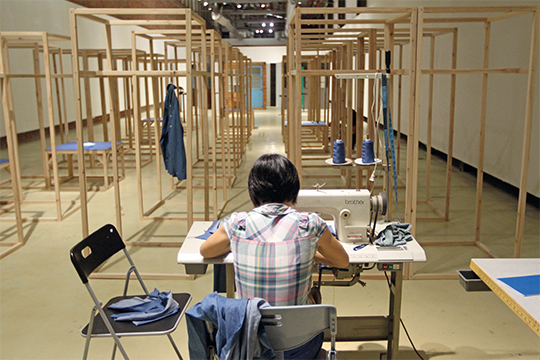WE HAVE NEVER PARTICIPATED: THE 8TH SHENZHEN SCULPTURE BIENNALE
| September 5, 2014 | Post In LEAP 28

Installation, dimensions variable
Joseph Beuys’ theory of social sculpture is a philosophical touchstone for Marko Daniel, curator of the 8th Shenzhen Sculpture Biennale. As he sees it, social sculpture expands the concept of sculpture beyond physical form and into the realm of social relations. It also anticipates the interactive, cooperative, and participatory paradigm in which“everyone is an artist.” Today, the origins of the controversial fields of relational and participatory art can be traced back to social sculpture, but these genres in the contemporary art system have completely diverged from the radical practices and utopian ideals of the 1960s and 70s.
This divergence may be the result of crises encountered by the participatory art of the present. To paraphrase Gene McHugh’s definition of post-internet art, participation is already “less a novelty and more a banality.” Doubts regarding relational art expressed by Jacques Rancière, Claire Bishop, and Nicolas Bourriaud are evident here: they seek to employ more radical forms of participation in order to confront a social medium and aesthetic pattern that has already become systematized and capitalized. But even more radical participation loses its capacity to intervene and critique when all participation becomes a kind of spectacle. According to Markus Miessen, participation has reached a tacit reconciliation with authority in the name of democracy, equality, and social justice. Although its significance has fundamentally changed, we cannot fully cast off participation. For the Biennale, Daniel ingeniously chooses the notion of post-participation to describe a kind of art that has already been widely embraced.
The exhibition’s title, “We Have Never Participated,” refers to Bruno Latour’s text, We Have Never Been Modern, and hints at the idea of post-participation. Specifically, it is a response to the way relational aesthetics and social participation have already been co-opted by spectacle and the system. Indeed, this is a vital question facing the world’s artists today. Boris Groys’ proposal is to return to reflection and observation as means of viewing art. Okwui Enwezor, Carolyn Christov-Bakargiev, and Massimiliano Gioni strive for new languages of art and exhibition-making from the perspectives of anthropology. Artforum recently published a series of Thierry de Duve essays on Duchamp and modernism that reaffirm the identity of the artist while implying skepticism regarding this anthropological model, while curators like Marko Daniel are left wondering what other approaches might be possible.

HD video, light boxes, installation
For the Biennale, Daniel does not return to reflection and observation, nor does he revisit modernism or explore possibilities outside of art. Daniel insists on the tension, subversion, and destructiveness of art itself, and he locates these qualities at the intersections between autonomous practice isolated from outside interference and the artist’s nuanced perceptions of everyday political, social, and cultural experience. On this foundation, he seeks to move past simple binaries between relational aesthetics or social participation on one hand and anthropology or artistic identity on the other. He chooses artists entirely on their artistic practices without consideration of identity, opinion, age, gender, or other labels and characteristics beyond art.
Daniel employs no themes and designates no modules; the exhibition space is arranged based on the relationships between the material qualities of the artwork. The most prominent aspect of the exhibition is the individual’s quotidian experience of public intervention. In Always I Trust, Cheng Ran uses the media of video and installation to transform a piece of electronic junk mail he received into a fictitious romance. Hong Kong movie star Carina Lau takes on the role of his love interest as the story evolves away from a purely personal and private narrative. Japanese artist Miero Koizumi’s videos in Theatre Dreams of a Beautiful Afternoon are of a “real” subway ride. Whether he is talking to himself or weeping, the other passengers seem to consider it nothing out of the ordinary, and it is not until he suddenly screams that they break their silence. The artist intends to use an extreme narrative form to test and challenge the daily pressures and oppressions we endure in order to survive. Similarly, Manuel Saiz’s Public Display of Affection is a performance, but not the kind of spectacle that could be observed and consumed. Saiz is curious whether this sort of formal medium might use a fixed, fabricated narrative to offer an authentic experience to the observer. Other works, such as Lai Chih-Sheng’s Border_SZ, Morgan Wong’s I Got Time, and Héctor Zamora’s Opening Up also use provocations of self-perception to intervene in public experience.

Installation, dimensions variable
There are also a corresponding number of artists who base their practices in everyday individual experience but express ambiguous relationships between that experience and public affairs. They dare to explore the limits of individual cognitive experience in the name of intervening in the public sphere. Qiu Zhijie and Song Zhen’s Total Art Studio produces The Society—Diankou, Village Furniture, a direct intervention into the political environment and society of a village in the name of fomenting culture in the countryside. Cao Fei’s Haze and Fog is a video narrative about the haze in Beijing; Li Jinghu’s Sea Breeze and Huang Po-Chih’s Production Line— Made in China relate, to various degrees, to the role of the Pearl River Delta as the world’s primary manufacturing, production, and distribution center; Chen Chieh-Jen’s Realm of Reverberations, Yao Jui-Chung’s Mirage, and Tsong Pu’s Beckoning to a Myth House all spring from the artists’ individual historical memories and life experiences. However, none of these artists sets out to intervene in the public sphere or instigate public incidents. Instead, they compress their own micro-interventions and individual realizations into an actualized intermediary form.
As Daniel sees it, “We Have Never Participated” describes not the relationship between the everyday experiences of artists and the public, but rather the artists’ chosen language of expression and the corresponding personal-public relationships they entail. The exhibition embraces a variety of mediums, but not as ends in themselves. Similarly, it touches on a variety of levels of individual and public intervention, but the point was not intervention or participation per se. Rather, it is the potential activation of a certain tension between the two. It would be impossible to prevent some degree of neutralization and reconciliation in this dynamic, but the exhibition successfully precludes the possibility of becoming spectacle. As a result, this curatorial project ultimately distances itself from post-participation. Unlike social participation, Daniel’s vision entails a kind of radical, strategic performance; unlike relational aesthetics, its intervention has a direct target, and thus avoids becoming an aimless, uncertain narrative.

